
A Vehicle Defect Caused Your Crash. Was It Negligence?
Many people are injured in a collision due to a vehicle defect. If you’re one of them, let’s work together to try and hold any negligent parties accountable.
Defective Car Lawsuits
It seems like a year doesn’t go by without hearing about another recall for a defective vehicle part. GM ignition switches. Firestone tire tread separation. “Stuck” accelerators on Lexus and Toyota vehicles. The Takata airbag recall that grew to so many recalls the company was forced into bankruptcy.
The list of recalls is long – and in many instances deadly. One thing is for certain. Many of these defective products are the result of corporate negligence.
One family suffered a horrible fate when a Jeep collided head-on with their car. The driver and the first passenger were saved from life-threatening injuries because of their seatbelts. However, due to the defective design of the middle seat lap-belt, the second passenger was gouged across her stomach by the seat belt, causing severe abdominal injuries that led her to death. It was the seatbelt that ultimately caused her death, not the collision.
If you or someone you know has been injured or killed in a collision because of a vehicle defect, contact us or call 1-866-900-7078 for a free case evaluation. You may be entitled to compensation that may potentially include medical expenses, lost wages, and pain and suffering, among other compensation.
Types of Vehicle Defects & Their Consequences
ClaimsJournal.com cites a study showing that automakers on average order recalls on 54% of models in the vehicle’s first year of production. Hyundai ranked highest with 67% affected by recalls in the first year; Toyota ranked lowest at 42%.
Vehicle defects can take multiple forms from an obvious tire blowout to precisely timed electronic mechanisms that are harder to identify. Or they can be a series of defective parts and systems leading to a problem, or a single defective part.
Fires
In 2015 there were a staggering 174,000 vehicle fires resulting in 445 deaths.
Car fires are often the result of fuel system or electrical defects. Both electrical and fuel-fed fires are often caused by manufacturing or design defects. Additionally, if the vehicle components are not designed to minimize the spread of fire, the consequences can be even more disastrous.
Millions of vehicles have fuel system integrity problems. In recent years, every major car manufacturer has had to recall vehicles due to defects in fuel systems. General Motors recalled more than 1.4 million cars in 2015.
Other fire risks can occur under the hood. BMW recalled 1.4 million cars in 2017 because of a risk of underhood fires. An electrical short in the braking system with the potential to ignite caused a 2018 Hyundai recall of 88,000 cars.
Brake Systems
Today’s braking systems are highly complex and must work together to be effective. When one part is defective, the whole system could potentially fail and your safety could be compromised. A defective brake system could mean your car can’t come to a complete stop, or it stops when you aren’t expecting it to. It could even cause rollovers if a car is pulled to one side of the road.
Defective brakes decrease the amount of control a driver has over their car which can often lead to a severe or fatal collision.
Defective brakes can be due to poor design, such as a defective parking break, brakes that overheat, or because of manufacturing failures, such as negligent installation.
Airbags
A defect in this safety feature could turn a bad situation into a deadly one. The NHTSA called the Takata airbag recall “the largest and most complex safety recall in U.S. history.” Airbag recalls, including Takata, include vehicles manufactured by Honda, Toyota, Lexus, Chrysler, some Ford vehicles and many many more.
Like braking systems, an airbag failure could be the result of a design flaw, manufacturing error, or faulty installation. Common types of failures include:
- Late deployment when air bag deploys unexpectedly after a collision and inflicts greater physical damage
- Failure to deploy which may lead to neck, back, head, and facial injuries
- Accidental or unprompted deployment may cause a driver to lose control of the vehicle and suffer serious injuries both from the impact of the air bag and a resulting auto wreck
Acceleration Issues
Sudden acceleration occurs when a car’s electronic systems cause the throttle to open and limits the ability of the brakes to regain control. The NHTSA defines this as “unintended, unexpected, high-power accelerations from a stationary position or a very low initial speed accompanied by an apparent loss of braking effectiveness.”
Unexpected acceleration can happen any time during a driving cycle, though it most often occurs when a vehicle is shifted from “Park” to “Drive.” It also can occur when a driver shifts gears, depresses the brakes, ends cruise control, and more. Other acceleration issues include accelerators that stick or break.
Acceleration issues lead to runaway cars, making this issue among the most deadly of vehicle defects.
Defective Tires
The NHTSA reports that over 11,000 tire-related crashes happen every year, resulting in serious injuries and deaths.
Instances of negligent tire manufacturing and tire failure can include:
- Tread separation which can be both design or manufacturing errors that cause a tire to wear out quickly and lead to a possible blowout
- Tire installation negligence often occurs when tires are not mounted properly, and can happen from:
- Not using a bead lubricant
- Stretching or tearing the bead because a tire was not correctly positioned
- Incorrect positioning of the tire that can lead to bead damage which may cause tires to leak air or suffer bead failure later
- Overinflating tires in an effort to seat them
- Tire blowouts which typically occur when something allows air to escape and prevents a tire from supporting a vehicle’s weight, often leading to a lack of vehicle control
Rollovers
The NHTSA estimates that 35% of all auto accident deaths are caused by a rollover.
A primary contributor of a vehicle rollover is something known as “tripping.” Tripping occurs when a tire hits something that disrupts the momentum of the car and causes it to rollover. NHTSA estimates that 95% of all rollovers are caused by tripping. Here are other rollover causes:
- Tire Failures
- Tire Tread Defects (delamination or detreading)
- Poor Stability Control
- Poorly Designed Suspension Systems
- Inadequate Brakes
Steering Systems
Steering systems involve much more than simply your steering wheel, and can manifest from the following car issues:
- Fluid pumps or lack of fluid
- Defects in hydraulic lines
- Leaky or loose hoses
- Problems with relay rods or steering knuckles
- Poorly secured components and other manufacturing problems
When any of these systems fail or have defects, your safety is at risk.
Seatbelts & Restraint Systems
According to the CDC, seatbelts reduce the risk of serious injury and death by over 45%. Seatbelts were designed to keep occupants in the vehicle. They save hundreds of lives every day by preventing ejectment. A 2012 report claims seatbelts save 15,000 lives every year. But what happens when a seatbelt is defective?
A defective seatbelt can turn an accident into a catastrophe. If it is not working properly, it can’t prevent injury or death, and in many cases, it may become the cause. Common seatbelt failures include:
- Inertial latching which occurs when the force of the collision causes the seatbelt to become unlatched
- False latching which occurs when the latch plate looks secured or sounds secured, when it is actually not completely fastened
- Torn seatbelt webbing which occurs when the force of an accident causes the seatbelt to tear or rip during a collision
- Retracting failure can occur when your seatbelt does not retract properly or “lock” properly.
- Lap-only belts. These are not designed to adequately protect the body, including the head, spinal cord, and internal organs, from injury in a collision.
Door Latch Systems
Failed door latch systems may leave a car door unlocked or even open when a car is in motion or during an accident. The NHTSA reported that more than 8,000 people are ejected from their cars through open doors due to failed latch systems every year.
Door latch defects are generally because of negligent design or manufacturing and can include doors that:
- Don’t close properly
- Become jammed
- Randomly unlock
- Break
Ignition Systems
Ignition system defects may arise when vehicles are fitted with faulty ignition switches that can cause an engine to shut off while in motion. GM’s infamous faulty ignition switches killed and injured occupants when the switch would suddenly shut down the vehicles in certain conditions, such as driving on rough roads or when the driver had an especially heavy key ring. GM took more than 10 years to issue recalls.
Fuel Systems
Fuel system defects may potentially occur if:
- Fuel tanks are positioned invertly or unguarded
- Fuel tanks are improperly installed
- Fuel systems rupture or leak gas
- Anti-puncture shields are ineffective or improperly installed
- Fuel lines break apart and leak fuel
Faulty fuel systems may lead to vehicle fires and explosions, which could result in severe burn injuries and even death.
Types of Injuries from Vehicle Defects
Many vehicle defects that cause or contribute to a collision may lead to severe injuries, including:
- Road abrasions
- Broken bones
- Brain and spinal cord injuries
- Paralysis
- Burns
- Scarring
- Death
Are Vehicle Defects the Result of Negligence?
Quite possibly. But unless you are a lawyer – and an experienced one – trying to prove negligence is very expensive, time consuming, and very complex. You must show injuries and losses, a manufacturing defect, design defect, or failure to warn, and that the defect was the cause of the injury – among other things.
Get a Free Case Evaluation from NC Personal Injury Attorneys
Trying to prove negligence in vehicle defects cases to obtain compensation for injuries requires an experienced car accident lawyer.
If you have suffered an injury due to defective vehicle parts, contact our legal team, which has more than 150 combined years of legal expertise.
Call us at 1-866-900-7078 or click the live chat option to speak with someone right now. Your case evaluation is absolutely free. And if we take your case, we will take it on a contingency fee basis – meaning you owe us no attorney’s fee if we are not able to recover for you.2

